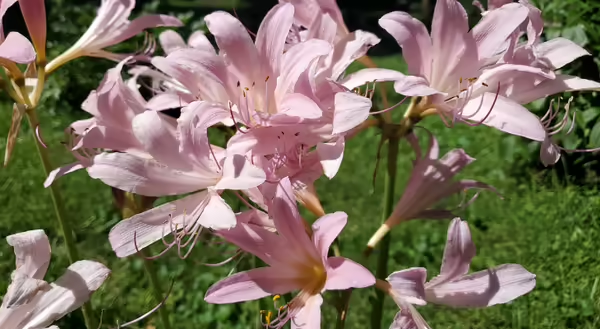
When I try to think of plants that live up to their common name, surprise lily (Lycoris squamigera) tops the list. In fact, this plant has quite a few common names that are equally fitting, including ghost lily, magic lily, resurrection flower, naked lily, and mystery lily, among many others. I think the shock factor that this plant presents in late summer has led to so many interesting and aptly applied names and its widespread use as a garden plant.
Surprise Lily is in the Amaryllis family. Its flower structure is pretty typical among its other family members, consisting of pink, funnel-shaped flowers with long and showy stamens extending well beyond the petals. The flowers are quite fragrant and can be found in full bloom across central Illinois.
A Welcome Surprise
However, it is these tall, dangly flowers that cause such surprise when they emerge. Unlike most other perennials, the foliage of this plant disappears long before its spindly, naked flower stalks shoot up from the same location. The sudden appearance of such showy flowers is truly ghostly for the casual observer that missed its foliage earlier in the season.
I was surprised by this plant the first year we lived at our current house. I had observed the lush, strap-like foliage emerge in late winter but could not figure out what plant I was seeing. At first observation, I’d thought it might be some kind of daffodil on steroids, given its early emergence, although the leaves were much thicker than a typical daffodil.
After waiting and waiting for a flower stalk to develop, the leaves finally withered and died as the hot weather of summer arrived in early June. I wrote the plants off as likely too unhealthy or stressed to flower.
Near the end of July, I noticed the naked stems of surprise lilies emerging around our yard and woodland edge. By that point in the gardening season, I had all but forgotten the thick, green foliage from earlier in spring. It took several looks to connect the leaves from earlier in the season to the flower stalk I saw. From past experience, I certainly knew what surprise lily flowers looked like, but had never observed the foliage.
This growth strategy is rare among ornamental plants. It is designed for survival in climates with moist, productive springs and drought conditions later in the year. The plant performs all of its energy production prior to the onset of hot weather and then flowers using its energy reserves later in the season.
Adding to this lifestyle's uniqueness is that surprise lily flowers are sterile and produce no seed. The plant relies entirely on slowly spreading bulbs to expand its population. It is quite efficient at producing and storing energy below ground, concentrating on producing flowers and bulb structures.
Surprise lilies are native to Asia and have been cultivated for centuries. They arrived in the US around the late 1800s and have been used as garden plants ever since. In some areas, they have been able to form naturalized populations, but they are not known to have overly invasive habits. Their slow rate of spread through bulb offsets is likely a limiting factor.
A Low Maintenance Oddity
If you want to add this oddity to your garden, they are relatively tough, low-maintenance plants readily available from most bulb suppliers. They do best in full sun to part shade locations with fairly good drainage but can certainly handle less than optimal conditions.
It can be tricky to integrate these plants into the landscape without being left with a bare appearance after spring foliage fades. Since their flower stalks are so bare and spindly, they have a bit of a stark appearance, even during their flower display. I think they work best with other perennials that provide interesting foliage throughout the growing season, such as hostas or low-growing ground covers which contrast nicely with their tall and showy flower scapes.